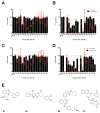Divide et impera: An In Silico Screening Targeting HCMV ppUL44 Processivity Factor Homodimerization Identifies Small Molecules Inhibiting Viral Replication
- PMID: 34065234
- PMCID: PMC8160850
- DOI: 10.3390/v13050941
Divide et impera: An In Silico Screening Targeting HCMV ppUL44 Processivity Factor Homodimerization Identifies Small Molecules Inhibiting Viral Replication
Abstract
Human cytomegalovirus (HCMV) is a leading cause of severe diseases in immunocompromised individuals, including AIDS patients and transplant recipients, and in congenitally infected newborns. The utility of available drugs is limited by poor bioavailability, toxicity, and emergence of resistant strains. Therefore, it is crucial to identify new targets for therapeutic intervention. Among the latter, viral protein-protein interactions are becoming increasingly attractive. Since dimerization of HCMV DNA polymerase processivity factor ppUL44 plays an essential role in the viral life cycle, being required for oriLyt-dependent DNA replication, it can be considered a potential therapeutic target. We therefore performed an in silico screening and selected 18 small molecules (SMs) potentially interfering with ppUL44 homodimerization. Antiviral assays using recombinant HCMV TB4-UL83-YFP in the presence of the selected SMs led to the identification of four active compounds. The most active one, B3, also efficiently inhibited HCMV AD169 strain in plaque reduction assays and impaired replication of an AD169-GFP reporter virus and its ganciclovir-resistant counterpart to a similar extent. As assessed by Western blotting experiments, B3 specifically reduced viral gene expression starting from 48 h post infection, consistent with the inhibition of viral DNA synthesis measured by qPCR starting from 72 h post infection. Therefore, our data suggest that inhibition of ppUL44 dimerization could represent a new class of HCMV inhibitors, complementary to those targeting the DNA polymerase catalytic subunit or the viral terminase complex.
Keywords: HCMV; PAP; antivirals; pUL54; ppUL44; protein-protein interactions; screening; small molecules.
Conflict of interest statement
The authors declare no conflict of interest. The funders had no role in the design of the study; in the collection, analyses, or interpretation of data; in the writing of the manuscript, or in the decision to publish the results.
Figures









Similar articles
-
The flexible loop of the human cytomegalovirus DNA polymerase processivity factor ppUL44 is required for efficient DNA binding and replication in cells.J Virol. 2009 Sep;83(18):9567-76. doi: 10.1128/JVI.00669-09. Epub 2009 Jul 1. J Virol. 2009. PMID: 19570866 Free PMC article.
-
PD0084430: a non-nucleoside inhibitor of human cytomegalovirus replication in vitro.Antiviral Res. 2001 Dec;52(3):289-300. doi: 10.1016/s0166-3542(01)00170-x. Antiviral Res. 2001. PMID: 11675146
-
Inhibition of Human Cytomegalovirus pUL89 Terminase Subunit Blocks Virus Replication and Genome Cleavage.J Virol. 2017 Jan 18;91(3):e02152-16. doi: 10.1128/JVI.02152-16. Print 2017 Feb 1. J Virol. 2017. PMID: 27881652 Free PMC article.
-
Drug targets in cytomegalovirus infection.Infect Disord Drug Targets. 2009 Apr;9(2):201-22. doi: 10.2174/187152609787847758. Infect Disord Drug Targets. 2009. PMID: 19275707 Review.
-
Small Molecules-Prospective Novel HCMV Inhibitors.Viruses. 2021 Mar 12;13(3):474. doi: 10.3390/v13030474. Viruses. 2021. PMID: 33809292 Free PMC article. Review.
References
-
- Loregian A., Appleton B.A., Hogle J.M., Coen D.M. Specific residues in the connector loop of the human cytomegalovirus DNA polymerase accessory protein UL44 are crucial for interaction with the UL54 catalytic subunit. J. Virol. 2004;78:9084–9092. doi: 10.1128/JVI.78.17.9084-9092.2004. - DOI - PMC - PubMed
Publication types
MeSH terms
Substances
LinkOut - more resources
Full Text Sources
Research Materials

